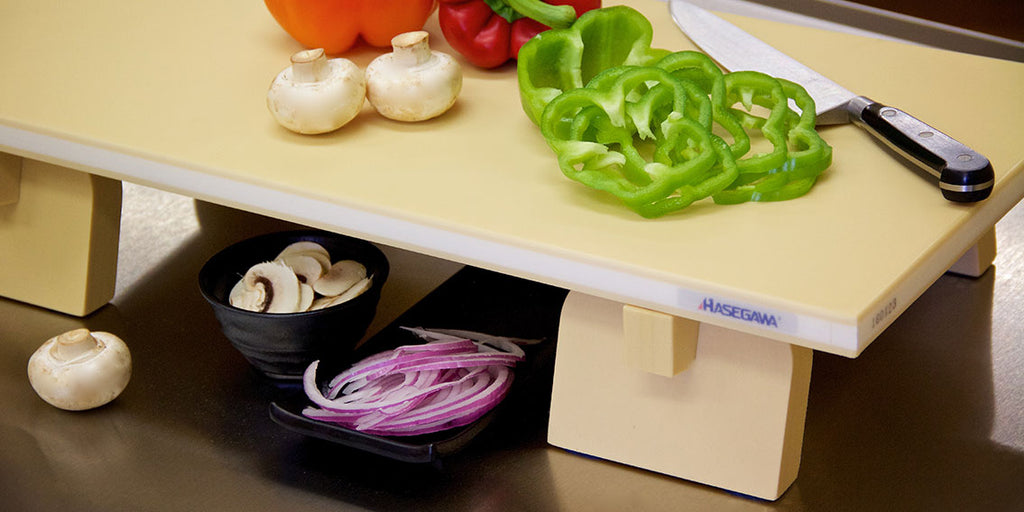The Ultimate Cutting Board Comparison Guide - Home & Professional Use
We often compare Japanese knives to luxury cars, and the comparison is an obvious one: they’re high performance, super pretty, and crafted with a lot of love. But just as you wouldn’t drive your Ferrari through the mud, you don’t want to cut on the wrong surface with your Japanese knife. Countertops, glass, granite, and even bamboo are very hard, so they quickly dull your knives. There’s a reason wood is the classic choice; it’s hearty enough to stand up to decades of use but soft enough to be easy on your knives. These are the best cutting board to use your Japanese knives on, with something for every type of cook and kitchen.
The Best Cutting Boards for Japanese Kitchen Knives

Larchwood
Larchwood cutting boards, crafted by hand in Cape Breton NS, are the gold standard at Knifewear. Just look how pretty they are! You can display these on your kitchen counter with pride and even use them to serve up charcuterie and cheese at dinner parties. These boards are made sustainably in Canada, so you can feel good about buying something with minimal environmental impact. Best of all, they’re created from “end-grain” wood. Notice the ring patterns on the top of the board? That means the wood was cut across the tree's grain, rather than along it.
This small detail makes the board a lot more work to manufacture but means they last far longer than conventional boards and are way easier on your knives. When your edge contacts the board, it’s cutting between the fibres of the wood, rather than against them the way it would with a side-grain board, allowing your knife to stay sharp much longer. End-grain construction also gives your board the ability to self-heal like Wolverine - when it gets nicks and gashes from use, the moisture in the wood will cause it to swell slightly, and those gaps will slowly fill with time. Additionally, end-grain doesn’t warp horizontally like regular boards, so you never end up with a super uneven cutting surface that rocks all over your counter. I’ve lost too many good boards to warping, but my Larch has stood the test of time, even in ultra-dry Alberta.

Stick and Boards
Now that I’ve spent all this time poo-pooing side grain boards let’s talk about them! While my favourite is obviously the Larchwood, they’re not for everyone. The extra labour that goes into making them also means a higher price point that isn’t accessible to everyone. They’re also bulky and heavy, so if you live in a small space or struggle to lift a heavy board, you may not want something that massive. If you’re on a tight budget or shopping for a gift, a side grain board may be the way to go! Remember, wood is always better than a harder material, so side-grain is still an excellent choice.
Based in Morewood, ON, Glen and Donna started Sticks and Boards as a way to make use of the offcuts they couldn't make furniture with. What began as a way to reuse leftovers quickly outstripped their scrap pile and led them to source wood specially cut for their needs from the local sawmill. They now produce a wide range of stunning cutting boards, knife blocks, and other kitchen accessories. Their boards are simple, elegant, and Canadian-made! Unlike Larch, they come in a lighter maple and a darker walnut, giving you options based on your kitchen aesthetic.

Tojiro Paulownia
The Paulownia cutting board from Tojiro is the perfect lightweight, slim option for your first apartment or on-the-go catering chef. This fast-growing hardwood is a sustainable choice prized for its warp resistance and extremely lightweight nature. We offer three sizes so you can find the perfect match for your space! They’re also super affordable, so if you’re grabbing gifts or equipping your first home, this guy is the easy to go. My favourite Paulownia board is the small as it’s great for kids. It’s light enough a young child can handle it with ease and bring it to the kitchen to learn their very first knife skills.
Hasegawa
You’ll notice I haven’t mentioned plastic yet. Despite being soft and easy to sanitize, plastic boards can gouge and harbour bacteria easily, meaning you have to be way more thorough when cleaning them. Hasegawa has solved these issues with their revolutionary plastic boards, and as a result, they carry a strong reputation among knife nerds and professionals. These are like the Toyota Prius of cutting boards, a perfect hybrid between a rigid wooden core and a soft plastic coating.
Hasegawa actually started as a ski manufacturer, but their unique wood-core construction methods made them perfect for creating a plastic-coated board that wouldn’t warp. The outer layer is quite soft and easier on your knife edges than any other board on this list. Remember when I mentioned plastic boards being hard to clean? Hasegawa solved that problem too! The boards are impregnated with ionized silver, which is completely safe for humans but essentially 'deactivates' bacteria on the board. While we still suggest washing them after cutting meat, these boards are far safer than standard plastic boards. They’re also our only option that’s dishwasher safe! Eventually, the surface will get gouged up, but they sell a special board scraper that refinishes your board’s surface like a sanding block.
As with any quality product, your cutting board requires some care, especially the wooden ones. Wash them by hand, moisturize them on occasion with Clapham or Knifewear Coconut Cutting Board Wax, and they can last decades! Check out this article for more on board care. If you need more help choosing a board, shoot us a message or visit us in-store! I guarantee you’ll love whichever one you end up with.






